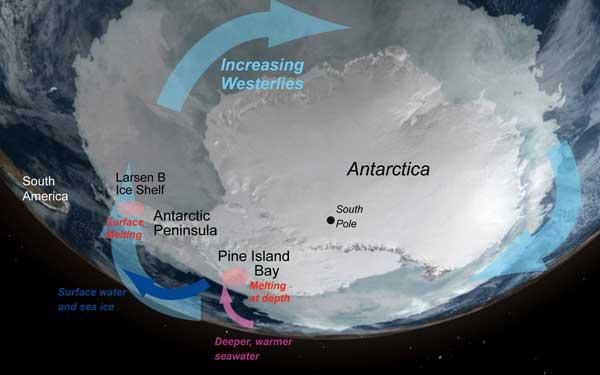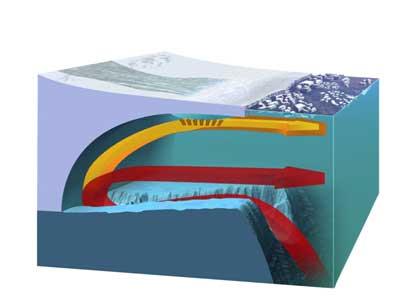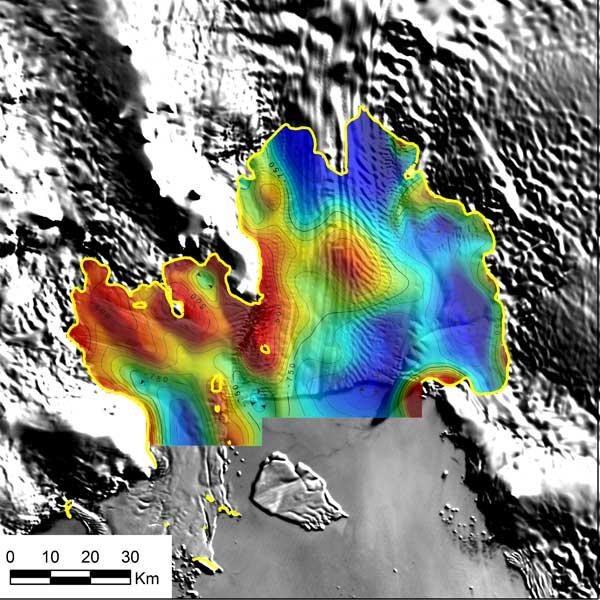
Puzzle of Antarctic Ice Melt Solved
Researchers have finally found an answer to a question they have been asking for years: Recent data and satellite information have indicated what has been driving the rapid loss of ice in Western Antarctica.
Glaciologists from the University of Colorado at Boulder and NASA's Goddard Space Flight Center in Maryland have combined data from various sources to determine why Western Antarctica two regions of it in particular, Pine Island and the Antarctic Peninsula have been losing ice mass so rapidly.
They have found that it comes down to wind and underwater channels carved beneath the ice that allow warmer waters to seep in.
"The westerly wind pattern drives everything in Antarctica," said Ted Scambos, a glaciologist at the National Snow and Ice Data Center in Boulder, Colo.
Over the past decades, the westerlies have become stronger, and as the wind moves faster, so does the water around the ice.

"Increased winds drag surface water faster, and this coupled with the Coriolis steers the water to the left and away from the continent, which leads to upwelling of warmer water into the area," said Bob Bindschadler, of NASA Goddard Center. (The Coriolis effect is due to the Earth's rotation, and causes air and fluid patterns such as ocean currents to deflect to the right in the Northern Hemisphere and deflect to the left in the Southern Hemisphere.)
This warmer water in turn, contributes to the melting of the ice shelves, several of which have disintegrated in recent years, including the Larsen A and B ice shelves.
Sign up for the Live Science daily newsletter now
Get the world’s most fascinating discoveries delivered straight to your inbox.
Airborne data showed the ice shelf was up to 492 feet (150 meters) thinner when the warmer water was present, allowing Bindschadler's team to establish a direct link between the rate of ice shelf melting and atmospheric wind speed. When the team accounted for the heat coming in and the ice lost, they concluded that only 22 percent of the heat is used in melting.
"Only one-fifth of the heat under the ice shelf is actually converted to ice melt," Bindschandler said. "Most stays beneath the shelf, which leaves them vulnerable."

NASA's Ice Bridge mission provided measurements beneath the ice shelves that indicated how this warm water was taking its toll on not only the ice shelves, but Antarctica's land-bound ice sheets as well.
IceBridge is a six-year campaign to survey and monitor areas of Earth's polar ice sheets, glaciers and sea ice and how they are responding to climate change.
"Deep channels under the ice allow warm water to flow all the way to the grounding line, where the ice shelf meets the bedrock," said Michael Studinger, a researcher with the mission. "These channels provide a pathway for the warm water to reach the ice sheet itself."
The effects have been imprinted onto the bottom of the ice shelves. Bindschandler and his team observed waves on the top of the ice sheets that were between 33 and 48 feet (10 and 15 meters) tall; when they correlated those to waves on the bottom of the ice shelf , there was a noticeable difference.
"Underneath these waves were much larger waves on the bottom of the ice shelves, caused by melting," Bindschandler said. The waves on the bottom were between 328 and 492 feet (100 to 150 meters).

The IceBridge mission will continue to measure the ice in flyover missions next year, and Scambos and his team have placed instruments on glaciers just south of the area where the shelves disintegrated. The instruments and new aircraft flights will provide further insight into shelf break-up and the onset of ice acceleration. Researchers anticipate that further warming will lead to further glacier speed-ups.
"Understanding of the process of ice loss is necessary to predict what will happen with sea level rise in the coming century," Scambos said.









